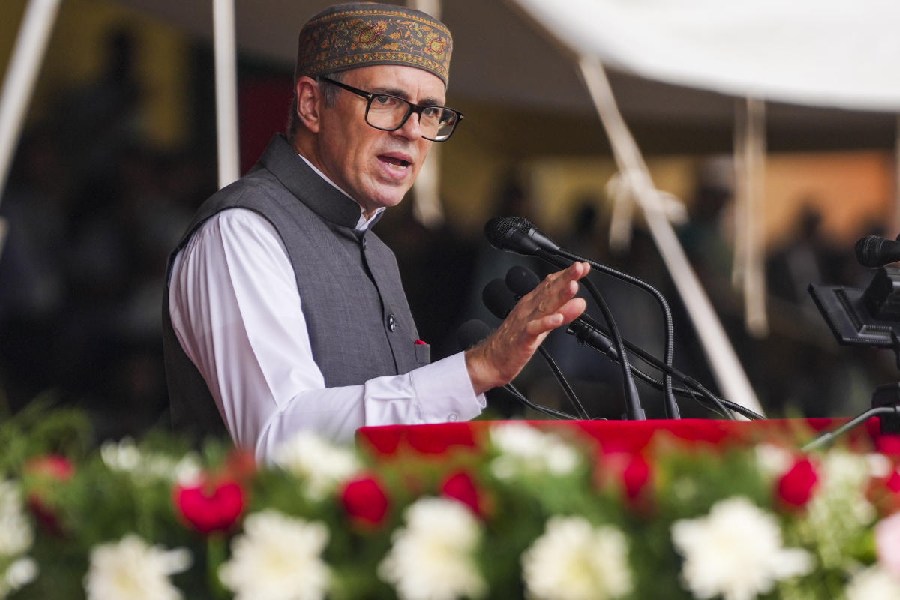 |
| Members of self-help groups who have benefited from the farm. Picture by Ripunjoy Das |
Assam has earned a bad reputation by incurring losses in almost every venture it has undertaken — be it an institute or a public sector unit.
However, there have been instances where the government agencies have reversed the losses through sheer hard work and sincerity.
The Dibrugarh district poultry farm is one such instance, which has of late shown significant progress with the active participation of the district administration, the District Rural Development Agency (DRDA), the farm authorities and its employees.
Located at Khanikar, five km from this Upper Assam town, the farm, owned exclusively by the Assam government, was established in 1966 to augment egg and chicken production in the state.
Like many other institutes in the state, it did not fully succeed in achieving its target in the past four decades, even though it has adequate infrastructure and boasts an area of 10 bighas.
However, a new initiative has now been launched to give a total facelift to the farm during the past couple of years.
“We have selected poultry as an area of core competency as rearing of fowls has been a familiar subject with the Assamese people,” said Dibrugarh deputy commissioner Niraj Verma. The new initiative has also been included in Dibrugarh Marching Ahead, a vision document prepared by the district administration.
Poultry is an ideal area in the co-operative sector considering the quick turnover, coupled with ample opportunity for self-employment with minimum investment. Accordingly, the district administration has set up a co-operative poultry project at the farm.
“The state government has earmarked five thrust areas in the livestock sector, of which the animal husbandry and veterinary department has taken up three. We are implementing the second, which is called ‘layer poultry farming’, to increase egg production,” said farm manager Himendu Bikash Baruah.
Farm development
As part of the new initiative, DRDA, Dibrugarh, under one of its schemes, has developed the infrastructure of the farm in order to strengthen it. It is being hoped that this can form the nucleus for poultry development in the district.
A sum of Rs 500,000 has been sanctioned for the project by the DRDA.
“The most important factor behind the joint initiative is the involvement of nearly 100-odd self-help groups (SHGs), who had been directly or indirectly benefited by the farm,” the farm manager said.
During the past year, the day-old chick production has been a healthy 15,056. These have been supplied to the members of the SHGs and individual farmers. The cumulative egg production from August 2002 to September 2002 is 1,35,000.
From a loss-making unit, the farm has turned around and is now earning good revenue for itself. “Our monthly income now stands between Rs 80,000 and Rs 100,000, which we use as a revolving fund for procurement of feed,” Baruah said.
The farm has also set a target of producing 5,000 eggs per day from March next year.
The Dibrugarh district administration has constituted a joint management committee to run the instalment created under EAS fund in the farm. The committee has been authorised to manage the day-to-day operational affairs for smooth and effective maintenance of the project.
“The committee is also responsible for guiding the co-operative society in motivating the farmers for expansion of their poultry activities in other areas of the district,” committee secretary Arnab Konwar said.
Another major function of the farm is to ensure supply of day-old chicks at low prices.
“The price of such commercial layer is around Rs 30 in the open market, but we charge only half and add Rs 6 per week. So, a one-month-old chick would be priced at Rs 33 whereas in the open market the price is between Rs 55 and Rs 60,” the farm manager said.
Three kinds of hybrid chicks (Keystone Brown, FR-295 and BV-380), procured from Tamil Nadu, have been kept at the farm. The production of eggs per year from these birds is 300.
“These birds can be reared in a normal manner, like it is done in almost every rural household. But one can produce 200-250 eggs, whereas the local birds produce only 40-50 eggs per annum,” Baruah said.
Feed production
In order to tide over the cost of production for eggs, the farm had also installed a mini feed mill of its own. It has helped to produce feed for the birds at the farm and it also supplies feed for the SHGs, at a rate much lower than that of the market.
A village, which has four or five sincere and dedicated SHGs, is entitled to have the designation of a poultry village. Till date seven such villages have been designated. “It builds the concept of community farming of poultry among the SHGs and the output is also good for the farmers,” Baruah said.
Three sale booths have been opened in Dibrugarh to promote the sale of eggs and chicks. This move has been welcomed by the local people here in terms of accessibility.
“After individual sales, the farm is now exploring institutional sales like the police, army, airforce, Dibrugarh University, Assam Medical College and different hotels and restaurants, to boost up sales,” the farm manager said. “The police have already ordered 1,000 eggs per day from the farm,” he added.
However, the farm needs more support from the authorities to become more productive, and to compete with the produce brought in everyday from outside the state, particularly from Andhra Pradesh. The staff strength needs to be increased and the existing infrastructure brushed up. “The beginning has been encouraging, with particular involvement of rural women as members of SHGs. Now we will put in more effort,” said Baruah.
Hopefully, the farm will serve as an example for other entrepreneurs and government departments to “shine in spite of all odds,” he said.











